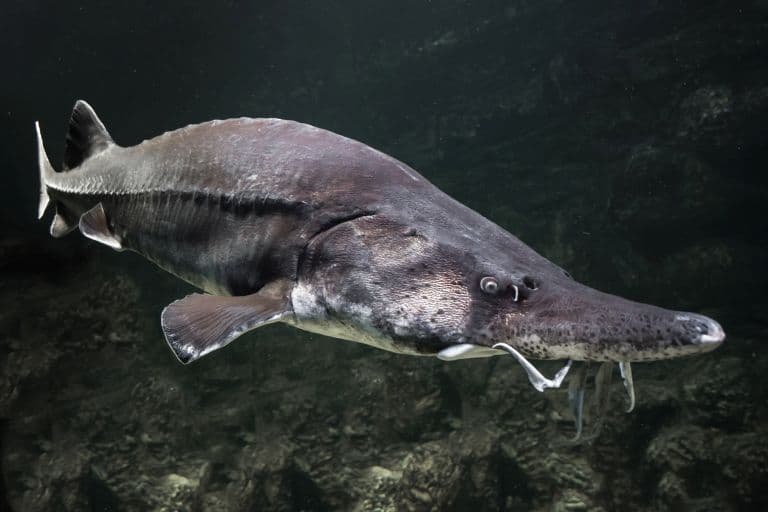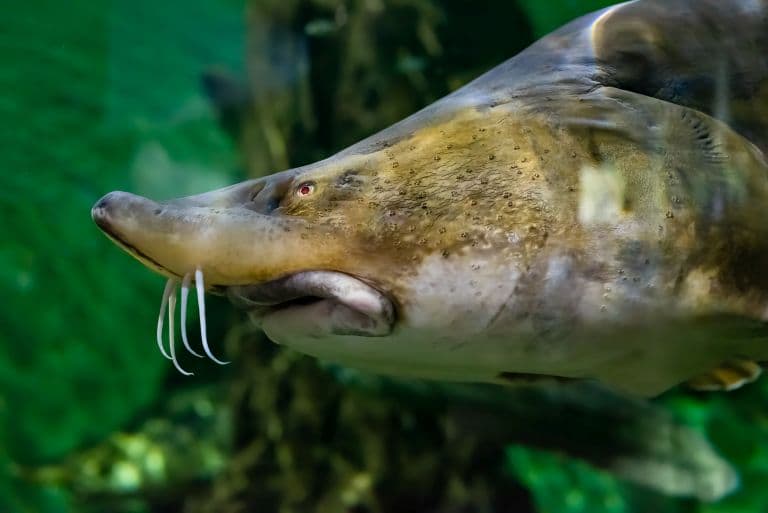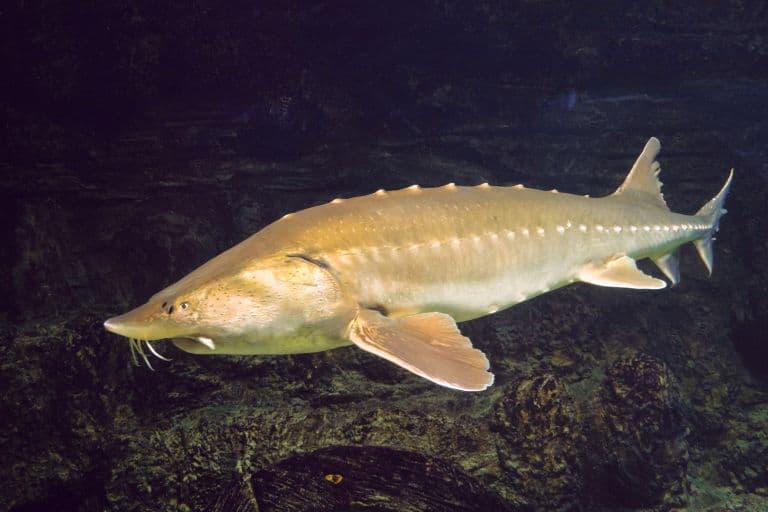Kaluga Profile
Everyone’s heard of beluga caviar, one of the most coveted animal products among the pretentious elite. And, by extension, most know that it comes from the beluga sturgeon, a true giant of the freshwater riverways, and hunted almost to extinction as a result.
But there’s a lesser-known sturgeon, suffering the same fate, and with none of the recognition.
The Kaluga Sturgeon, another river monster, is almost wiped out for the same reason, and it deserves to be known. Also known as the river beluga, this huge predatory sturgeon inhabits the Amur River basin in East Asia, which stretches between China and Russia.

Kaluga Facts Overview
| Habitat: | Marine and freshwater wetlands |
| Location: | Eastern Russia, Mongolia, Japan, China |
| Lifespan: | Over 70 years |
| Size: | 5.6 m (18.6 ft) |
| Weight: | With a maximum size of at least 1,000 kg (2,205 lb) |
| Colour: | They have gray-green to black backs with a yellowish green-white underbelly. Brown or grey |
| Diet: | Pike, carp, herring, chum salmon, keta |
| Predators: | Catfish, humans |
| Top Speed: | Unknown |
| No. of Species: | 1 |
| Conservation Status: | Critically endangered (IUCN) |
Kalua sturgeons are absolutely massive, powerful (mostly) freshwater predators. Similar to beluga, in that they actively hunt, and different than most sturgeon for the same reason, these exceptional fish are some of the largest on earth.
Unfortunately for these huge fish, not only do they breed slowly, but their very eggs are sought after by humans before they can be fertilised.
This has made them extremely vulnerable to destruction, and the species is now critically endangered as a result.
Interesting Kaluga Facts
1. They’re huge mothers
Kaluga sturgeons are only slightly smaller than their famous Beluga cousins. They can live for at least 70 years (we don’t know exactly how long because we keep killing them), and likely grow to well over a ton in weight.
A single gravid female of 500kg can contain four million eggs, which would be four million chances to pass on her genes if they weren’t so damn tasty.
This breeding strategy is known as R-strategy, where the R stands for “Really quite a lot”. It’s the scattergun approach to reproduction and involves sending as many gametes, eggs, larvae or baby animals out as possible, with the hope that at least two of them will survive.
It’s the opposite end of the spectrum from K-strategy (the K stands for Kumbersome and Kostly), which is what humans do, in which the parents spend about seventeen years trying to get one of them to straighten up and fly right.
Both have their strengths and weaknesses, but R-strategists are usually less susceptible to environmental changes and do better in unstable environments. And there’s definitely nothing stable about where the Kaluga lives. 1

2. They’re huge predators
An animal this large has an appetite to match. Kalugas are dominant in their ecosystems, and will happily swallow a large pike, carp, or even salmon if they can get their weird mouths around one.
By weight, they’re one of the heaviest active predators in the water and have immense top-down pressure on their ecosystems as a result.
3. They have alien mouths
In order to swallow these impressive meals, the Kaluga has an extendable, leathery mouth that sits under a gnomelike nose, and this is likely used as a rapid-release grabbing tool to ambush the Kaluga’s prey.
The mouth is particularly wide, and extends almost all the way around the head, giving this fish an ironic sort of smile.

4. They can move between fresh and saltwater
An animal well adapted to unstable environments is still usually restricted by the environmental conditions it’s familiar with. But this is a fish that’s capable of tolerating a wider range of salinity than most.
Rivers are where it breeds, but it will spend at least part of its life in salt water. Spawning happens on either side of a period of around 4-5 years in females, and 3-4 years in males, and eggs are laid in fast-moving freshwater, where the temperature will determine how fast females mature.
This is another interesting adaptation to a chaotic environment and would serve the animal well under normal circumstances. 2
5. Their offspring must fend for themselves
As R-strategists, the parents have no interest in their offspring after they’ve been ejected as eggs from the back end. Babies may stay inside the egg for a couple of weeks, and feed off a yolk for a week or two more after hatching. Then, they’re on their own.
At this stage, they’re exceptionally vulnerable to predation and will be eaten by almost anything bigger than they are. All they can eat are zooplankton, insects and crustaceans.
Since females can only breed every few years, their millions of eggs give them a fighting chance of survival. It will take these baby fish well over a decade to reach sexual maturity, and they will grow larger every year until they die.

6. They’re heavily threatened
So, despite having so many eggs, it’s clear why they’re all so important. A birthing event in Kaluga sturgeons is essentially an enormous chumming of the waters for all predators to enjoy.
But even before they’re spawned, these eggs are a target of a much more sinister predator: gastronomes.
Since 2008, China has witnessed an 80% decline in Kaluga. While the species is mostly protected, the price of its eggs creates a strong market for poaching, and over the past 100 years, the species as a whole has dropped by over 90%.
This might seem like a long time, but it’s a mere three generations for the fish. 3
7. Overfishing has almost wiped them out
Poaching is the major cause of their decline, but poaching is a result of their protected status, before which they were heavily overfished.
From 1957-2005, 117 tons of their eggs were being harvested each year. The slow rate of recovery from breeding so rarely means that pressure from increasing river pollution is a serious threat to the remaining populations.
The good news is, they’re doing better in captivity.
8. They’re being farmed
This species doesn’t do too badly on fish farms, which not only makes the production of the caviar cheaper but helps to guarantee their genetic stock.
Still, healthy genes are not a priority for fish farmers, and hybrids have been released back into rivers as a result of escaped experiments. Hybrids between the Kaluga and the Japanese sturgeon are now invasive in some areas, posing a threat to local species.
Further, the caviar industry doesn’t benefit from flooding the market with caviar, so they’re likely to keep the price high, which maintains the market for poaching of wild salmon.
Still, captive breeding, even for farming, provides conservationists with valuable data that could be used to maintain protective stock for the species.
9. The Kaluga might just bite back
There’s been rumours of large predatory fish in the Amur River basin attacking humans. The kaluga fish is the top suspect.
Kaluga Fact-File Summary
Scientific Classification
| Kingdom: | Animalia |
| Phylum: | Chordata |
| Class: | Actinopterygii |
| Order: | Acipenseriformes |
| Family: | Acipenseridae |
| Genus: | Huso |
| Species: | Huso Dauricus |
Fact Sources & References
- “R-strategists, K-strategists and Survivorship curves: The reproductive adaptations of different organism”, ECO-INTELLIGENT™.
- Hajime Matsubara (2012), “The Kaluga sturgeon (Huso dauricus) from the coast of southernmost Okhotsk Sea, Hokkaido, Japan”, J-Stage.
- “Kaluga”, IUCN Red List.
